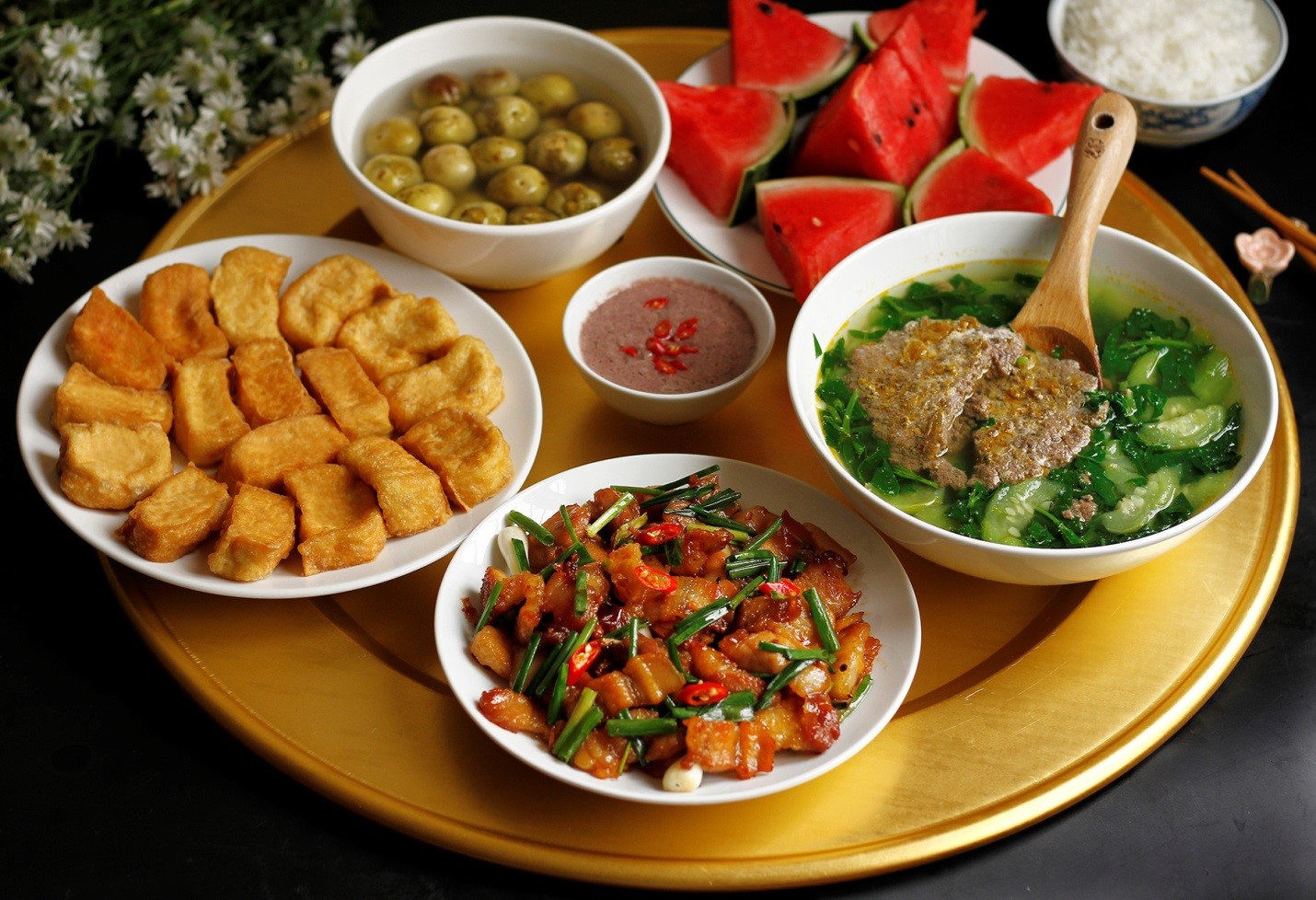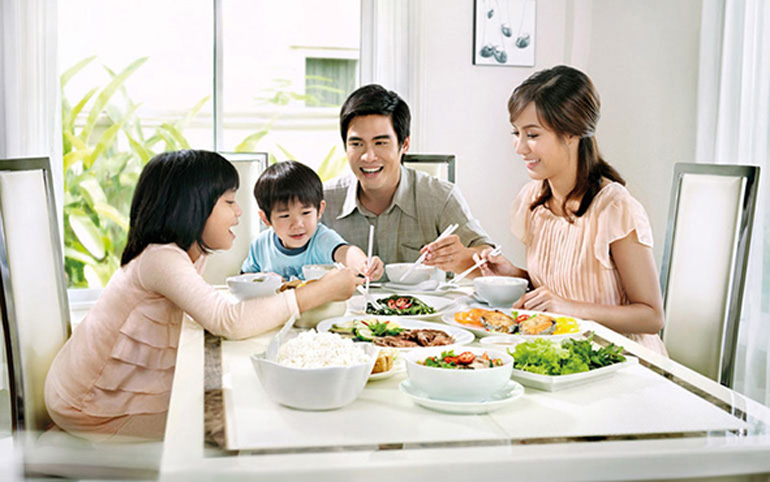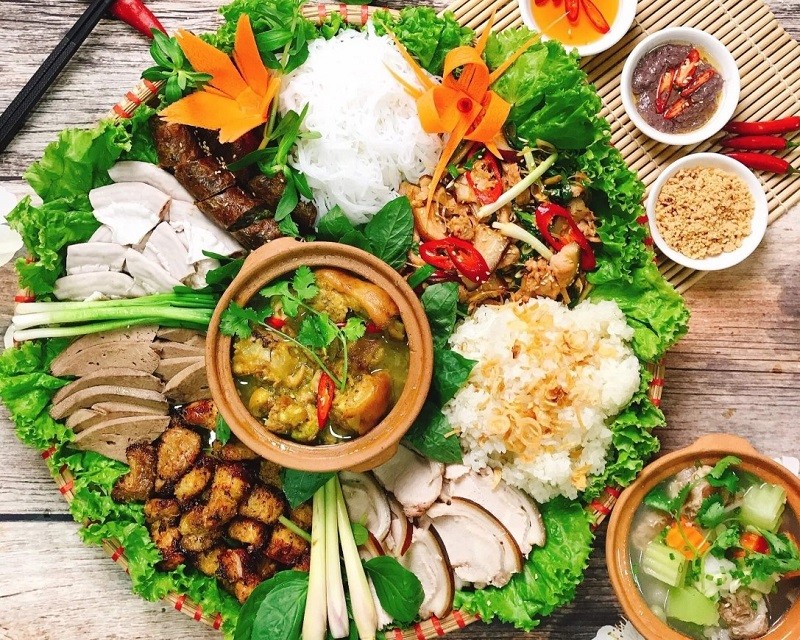1. The meanings of the traditional Vietnamese family meal
A typical Vietnamese family usually has 3 meals per day, with dinner being the most important meal. The traditional dinner has its roots in Confucianism, which symbolizes the unity and strength of the family. Therefore, family meals are the greatest time for everyone to sit down, share food together, and connect with each other through stories and sharing. In addition, preparing meals together is a way for elders to pass down their recipes and expand their culinary diversity in everyday life.2. Characteristics of a Vietnamese family meal
2.1. The food tray
 The Vietnamese family meal typically evolves around one food tray, usually a circle made from metal. The Vietnamese food tray is where all the food and the sauces are put, and the family members’ bowls are positioned around the tray. The circle trays represent the unity and togetherness of the family gathering.
The Vietnamese family meal typically evolves around one food tray, usually a circle made from metal. The Vietnamese food tray is where all the food and the sauces are put, and the family members’ bowls are positioned around the tray. The circle trays represent the unity and togetherness of the family gathering.
2.2. Typical Vietnamese family meal menu
 A typical family meal in Vietnam always has rice as the base. They will usually share three to four main dishes, with one savory dish with the main protein, one vegetable dish, and one soup. Unlike Western cuisine, where soups are appetizers, Vietnamese soups are usually eaten at the end of the meal before desserts, with or without rice. Vietnamese desserts are very simple, with a wide range of tropical fruits for them to choose from.
>>>> Check out more Vietnamese traditional food here.
A typical family meal in Vietnam always has rice as the base. They will usually share three to four main dishes, with one savory dish with the main protein, one vegetable dish, and one soup. Unlike Western cuisine, where soups are appetizers, Vietnamese soups are usually eaten at the end of the meal before desserts, with or without rice. Vietnamese desserts are very simple, with a wide range of tropical fruits for them to choose from.
>>>> Check out more Vietnamese traditional food here.
2.3. Talking while eating
 Vietnamese family meals, especially dinners, are when the family gathers together to share about their day and personal lives. Therefore, people will have a lot of conversations together while eating to fill in the silence. In many families, the elders also have the habit of turning on the television to talk while having family dinners.
Vietnamese family meals, especially dinners, are when the family gathers together to share about their day and personal lives. Therefore, people will have a lot of conversations together while eating to fill in the silence. In many families, the elders also have the habit of turning on the television to talk while having family dinners.
2.4. Sharing the food together
 Unlike Western dining customs, where each course is only brought out after people have finished the previous course, all Vietnamese dishes are brought out at once at the start of the meal, even the desserts. This is because people will share the food together by using chopsticks, and they will eat them with their rice bowls.
Unlike Western dining customs, where each course is only brought out after people have finished the previous course, all Vietnamese dishes are brought out at once at the start of the meal, even the desserts. This is because people will share the food together by using chopsticks, and they will eat them with their rice bowls.
2.5. Drinking while eating
 This might be a surprise for foreigners when visiting Vietnam, but a lot of Vietnamese male elders are used to having alcohol with their meals. They don’t just have it on celebrations or holidays, but in everyday meals and when they have guests too. The amount of alcohol they consume is also very moderate, usually just around one cup.
This might be a surprise for foreigners when visiting Vietnam, but a lot of Vietnamese male elders are used to having alcohol with their meals. They don’t just have it on celebrations or holidays, but in everyday meals and when they have guests too. The amount of alcohol they consume is also very moderate, usually just around one cup.
3. Typical dishes in a Vietnamese family meal in all 3 regions
3.1. Family meal in the Northern region
In northern Vietnam, the typical Vietnamese foods are usually lighter in flavor and very fragrant. Due to the mountainous geography, the northerners utilize a lot of forest herbs and vegetables, as well as freshwater fish or prawns. Some Northern dishes are also influenced by Chinese cuisine. Some popular Northern Vietnam family dishes are:- Sweet and sour pork ribs, clay pot braised fish, or pork
- Gourd and prawn soup, crab and spinach soup, sour fish soup
- Boiled vegetable dip with Vietnamese caramelized pork dip
3.2. Family meal in the Central region
Central region’s dishes will definitely give you a strong impression with their vibrant colors and strong spicy flavors. Since most of the region is right next to the Eastern Sea, their meals are very seafood-concentrated, giving you a diversity of fresh seafood like no other region. Some popular Central Vietnam family dishes are:- Crab, shrimp, snails, fish, steamed or salads
- Shrimp paste as a dipping sauce
3.3. Family meal in the Southern region
Probably the most foreigner-friendly cuisine, the Southern dishes usually have a very distinct sweet flavor. Brackish and saltwater seafood as well as vegetables are the main ingredients in their everyday meals thanks to the diverse Mekong River. Southerners, especially the Mekong Delta food, also tend to use dry dipping sauces for their meals. Some popular Southern Vietnam family dishes are:- Stir-fried beef with celery
- Snakehead fish sour soup, sour soup with tomatoes and beaten eggs
- Stir-fried water spinach with garlic
4. Vietnamese dining etiquette for foreigners in a Vietnamese family meal
- Say bon appétit: Always say “bon appétit” (Moi ca nha an com) before starting the meal to show respect and gratitude.
- Mind your sitting position: Be careful with where you sit to ensure a polite and comfortable dining experience.
- Using chopsticks: When using chopsticks, avoid touching the tips of your chopsticks to the bowl of soup or dipping sauces. Place them across the bowl when not in use. If you’re not confident using chopsticks, politely ask for a spoon or fork instead.
- Utilize your bowl of rice: Make good use of your bowl of rice by transferring food into the bowl before eating. Hold the bowl close to your mouth when eating rice for convenience and etiquette.
- Eat calmly: Eat slowly to savor your meal and enjoy the dining experience. Avoid eating too fast or stuffing too much food in your mouth at once. Engage in conversation with the family, rest your elbows on the table if needed, and ensure you don’t leave any excess food behind.
Conclusion
 The Vietnamese family meal is more than just a dining experience; it embodies the cultural values, unity, and warmth of families in Vietnam. Through a shared food tray, meaningful conversations, and diverse regional dishes, it captures the essence of Vietnamese hospitality and traditions.
>>> Read more about Vegetarian Vietnamese Food and Vietnam Street Food for your next Vietnam trip!
If you have the chance to join a Vietnamese family meal, don’t forget to try out the signature dishes and immerse yourself in the unique dining customs. Or, if you want to try out but don’t know where to start, contact YESD Travel for an authentic dining experience with the locals and explore the beauty of Vietnamese cuisine.
The Vietnamese family meal is more than just a dining experience; it embodies the cultural values, unity, and warmth of families in Vietnam. Through a shared food tray, meaningful conversations, and diverse regional dishes, it captures the essence of Vietnamese hospitality and traditions.
>>> Read more about Vegetarian Vietnamese Food and Vietnam Street Food for your next Vietnam trip!
If you have the chance to join a Vietnamese family meal, don’t forget to try out the signature dishes and immerse yourself in the unique dining customs. Or, if you want to try out but don’t know where to start, contact YESD Travel for an authentic dining experience with the locals and explore the beauty of Vietnamese cuisine.